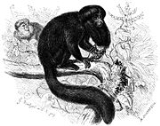
Black Bearded Saki
Encyclopedia
The Black bearded saki (Chiropotes satanas) is a species of bearded saki
, a type of New World monkey
. This critically endangered
species is endemic
to the far eastern Amazon
in Brazil
, it being restricted to a relatively small region from the Tocantins River
in Pará
east to around the Grajaú River in Maranhão
(similar to the range of the equally threatened Kaapori Capuchin
). It formerly included the red-backed
, brown-backed
and Uta Hick's bearded saki
as subspecies
or taxonomical insignificant variations (in which case the 'combined' species simply was called the bearded saki), but based on colour of pelage, karyotype
, and molecular analysis it has been recommended treating these as separate species. The black bearded saki is the only dark-nosed species of bearded saki with a blackish back, though some females and young have a paler, brownish back.
Bearded saki
The bearded sakis are five species of New World monkeys, classified in the genus Chiropotes. They live in the eastern and central Amazon in South America, ranging through southern Venezuela, Guyana, Suriname, French Guiana and northern and central Brazil...
, a type of New World monkey
New World monkey
New World monkeys are the five families of primates that are found in Central and South America: Callitrichidae, Cebidae, Aotidae, Pitheciidae, and Atelidae. The five families are ranked together as the Platyrrhini parvorder and the Ceboidea superfamily, which are essentially synonymous since...
. This critically endangered
Critically endangered
Version 2010.3 of the IUCN Red List of Threatened Species identified 3744 Critically Endangered species, subspecies and varieties, stocks and subpopulations.Critically Endangered by kingdom:*1993 Animalia*2 Fungi*1745 Plantae*4 Protista-References:...
species is endemic
Endemic (ecology)
Endemism is the ecological state of being unique to a defined geographic location, such as an island, nation or other defined zone, or habitat type; organisms that are indigenous to a place are not endemic to it if they are also found elsewhere. For example, all species of lemur are endemic to the...
to the far eastern Amazon
Amazon Rainforest
The Amazon Rainforest , also known in English as Amazonia or the Amazon Jungle, is a moist broadleaf forest that covers most of the Amazon Basin of South America...
in Brazil
Brazil
Brazil , officially the Federative Republic of Brazil , is the largest country in South America. It is the world's fifth largest country, both by geographical area and by population with over 192 million people...
, it being restricted to a relatively small region from the Tocantins River
Tocantins River
The Tocantins is a river in Brazil, the central fluvial artery of the country. In the Tupi language, its name means "toucan's beak" . It runs from south to north for about 2,640 km. It is not really a branch of the Amazon River, although usually so considered, since its waters flow into the...
in Pará
Pará
Pará is a state in the north of Brazil. It borders the Brazilian states of Amapá, Maranhão, Tocantins, Mato Grosso, Amazonas and Roraima. To the northwest it also borders Guyana and Suriname, and to the northeast it borders the Atlantic Ocean. The capital is Belém.Pará is the most populous state...
east to around the Grajaú River in Maranhão
Maranhão
Maranhão is a northeastern state of Brazil. To the north lies the Atlantic Ocean. Maranhão is neighbored by the states of Piauí, Tocantins and Pará. The people of Maranhão have a distinctive accent...
(similar to the range of the equally threatened Kaapori Capuchin
Kaapori Capuchin
The Kaapori capuchin is a capuchin monkey endemic to Brazil. This species is found in the Brazilian states of Pará and Maranhão. Formerly considered a subspecies of the weeper capuchin , it was recently elevated to species status....
). It formerly included the red-backed
Red-backed Bearded Saki
The Red-backed bearded saki, Chiropotes chiropotes, is a species of bearded saki, a type of New World monkey, from South America. It is found north of the Amazon River and east of the Branco River in Brazil and the Guianas. It is possible the scientific name C...
, brown-backed
Brown-backed Bearded Saki
The Brown-backed bearded saki, Chiropotes israelita, is a species of bearded saki, a type of New World monkey. It is endemic to the Amazon in north-western Brazil and southern Venezuela. It is possible the correct scientific name for this species is C...
and Uta Hick's bearded saki
Uta Hick's Bearded Saki
Uta Hick's bearded saki, Chiropotes utahicki, is an endangered species of bearded saki, a type of New World monkey. It is endemic to Brazil, where restricted to the Amazon between the Xingu and Tocantins Rivers. It was formerly treated as a subspecies of the more easternly C. satanas, but its back...
as subspecies
Subspecies
Subspecies in biological classification, is either a taxonomic rank subordinate to species, ora taxonomic unit in that rank . A subspecies cannot be recognized in isolation: a species will either be recognized as having no subspecies at all or two or more, never just one...
or taxonomical insignificant variations (in which case the 'combined' species simply was called the bearded saki), but based on colour of pelage, karyotype
Karyotype
A karyotype is the number and appearance of chromosomes in the nucleus of an eukaryotic cell. The term is also used for the complete set of chromosomes in a species, or an individual organism.p28...
, and molecular analysis it has been recommended treating these as separate species. The black bearded saki is the only dark-nosed species of bearded saki with a blackish back, though some females and young have a paler, brownish back.

